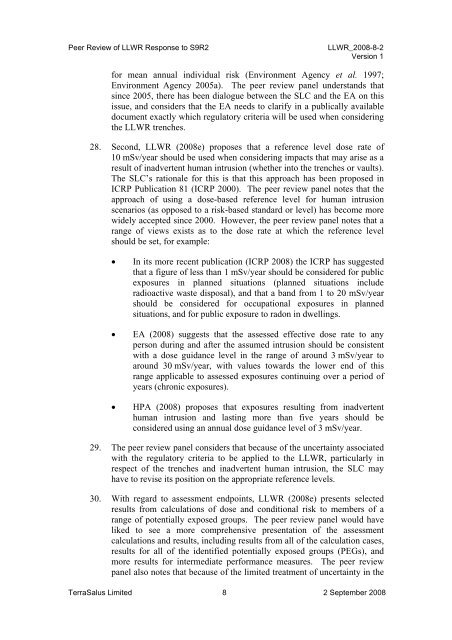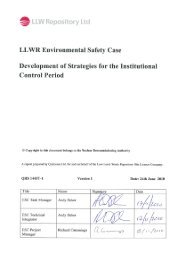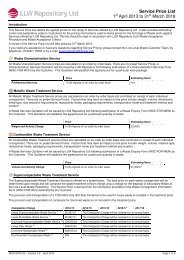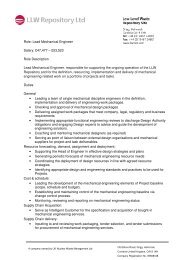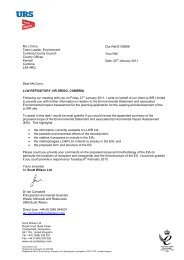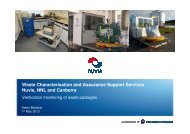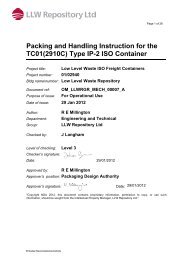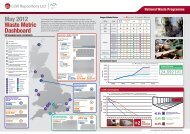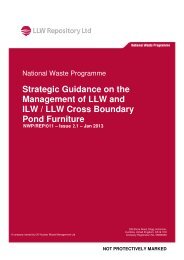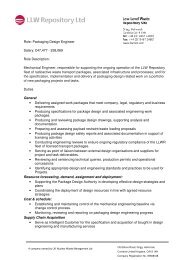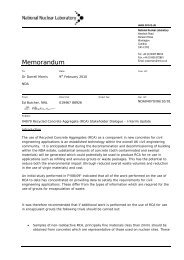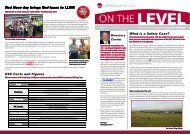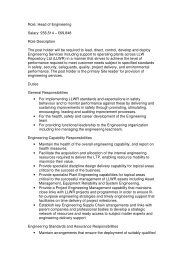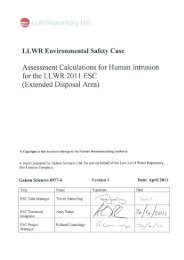Independent Peer Review of - Low Level Waste Repository Ltd
Independent Peer Review of - Low Level Waste Repository Ltd
Independent Peer Review of - Low Level Waste Repository Ltd
Create successful ePaper yourself
Turn your PDF publications into a flip-book with our unique Google optimized e-Paper software.
<strong>Peer</strong> <strong>Review</strong> <strong>of</strong> LLWR Response to S9R2LLWR_2008-8-2Version 1for mean annual individual risk (Environment Agency et al. 1997;Environment Agency 2005a). The peer review panel understands thatsince 2005, there has been dialogue between the SLC and the EA on thisissue, and considers that the EA needs to clarify in a publically availabledocument exactly which regulatory criteria will be used when consideringthe LLWR trenches.28. Second, LLWR (2008e) proposes that a reference level dose rate <strong>of</strong>10 mSv/year should be used when considering impacts that may arise as aresult <strong>of</strong> inadvertent human intrusion (whether into the trenches or vaults).The SLC’s rationale for this is that this approach has been proposed inICRP Publication 81 (ICRP 2000). The peer review panel notes that theapproach <strong>of</strong> using a dose-based reference level for human intrusionscenarios (as opposed to a risk-based standard or level) has become morewidely accepted since 2000. However, the peer review panel notes that arange <strong>of</strong> views exists as to the dose rate at which the reference levelshould be set, for example:In its more recent publication (ICRP 2008) the ICRP has suggestedthat a figure <strong>of</strong> less than 1 mSv/year should be considered for publicexposures in planned situations (planned situations includeradioactive waste disposal), and that a band from 1 to 20 mSv/yearshould be considered for occupational exposures in plannedsituations, and for public exposure to radon in dwellings.EA (2008) suggests that the assessed effective dose rate to anyperson during and after the assumed intrusion should be consistentwith a dose guidance level in the range <strong>of</strong> around 3 mSv/year toaround 30 mSv/year, with values towards the lower end <strong>of</strong> thisrange applicable to assessed exposures continuing over a period <strong>of</strong>years (chronic exposures).HPA (2008) proposes that exposures resulting from inadvertenthuman intrusion and lasting more than five years should beconsidered using an annual dose guidance level <strong>of</strong> 3 mSv/year.29. The peer review panel considers that because <strong>of</strong> the uncertainty associatedwith the regulatory criteria to be applied to the LLWR, particularly inrespect <strong>of</strong> the trenches and inadvertent human intrusion, the SLC mayhave to revise its position on the appropriate reference levels.30. With regard to assessment endpoints, LLWR (2008e) presents selectedresults from calculations <strong>of</strong> dose and conditional risk to members <strong>of</strong> arange <strong>of</strong> potentially exposed groups. The peer review panel would haveliked to see a more comprehensive presentation <strong>of</strong> the assessmentcalculations and results, including results from all <strong>of</strong> the calculation cases,results for all <strong>of</strong> the identified potentially exposed groups (PEGs), andmore results for intermediate performance measures. The peer reviewpanel also notes that because <strong>of</strong> the limited treatment <strong>of</strong> uncertainty in theTerraSalus Limited 8 2 September 2008


